Image
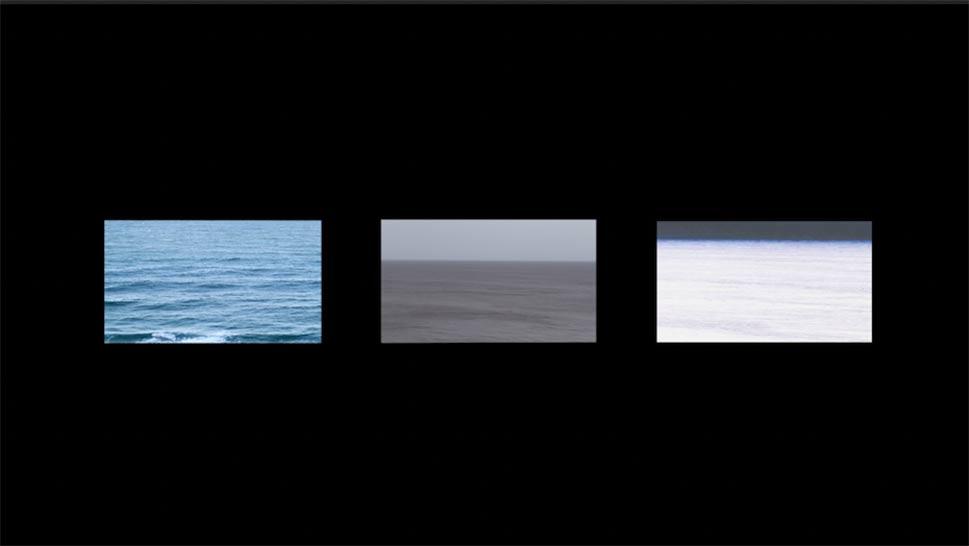
Elise Stephens
Wave Counter
Image

Script 1
We are beings with at once fragile and resilient senses.
Each of us have a threshold that is tested by auditory and visual stimuli that are seemingly constant.
Silence is a luxury. Silence requires an investment in time and attention.
“Best way to think of a beach is a river of sand…it’s always flowing. Always moving.” – wave counter’s voice
when I returned … sat down …. and attempted to make sense of the choppy seas, I was overwhelmed.
I expected an ocean landscape to look different, but familiar enough that I could get my bearings –
see the swells or lack of swells I saw before and make a comparison.
Now, when I look at waves, I think about the waves as they are, rotations in place, not as moving horizontally-
my way of thinking has changed.
while watching the video from one trip while listening to the audio from another I am folding in three different time dimensions.
This is to understand something that is timeless and eternal.
Video file
Image
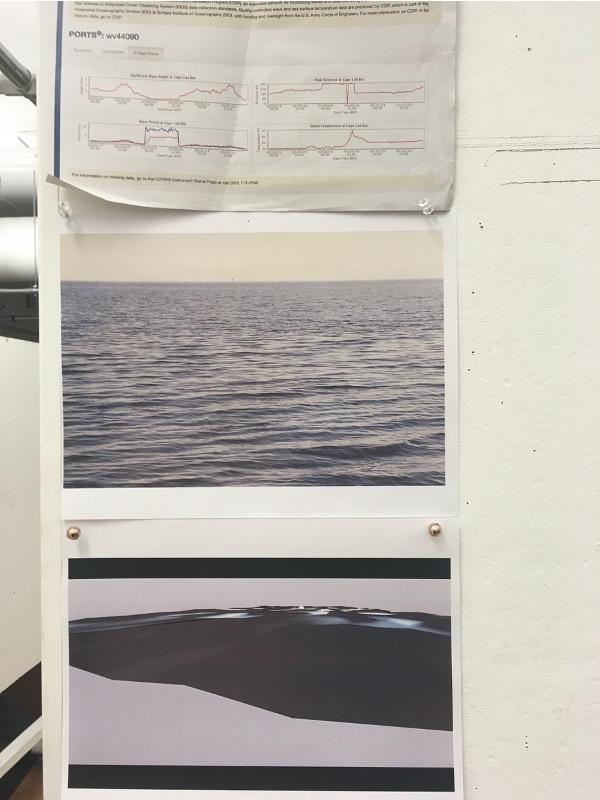
Image

Image
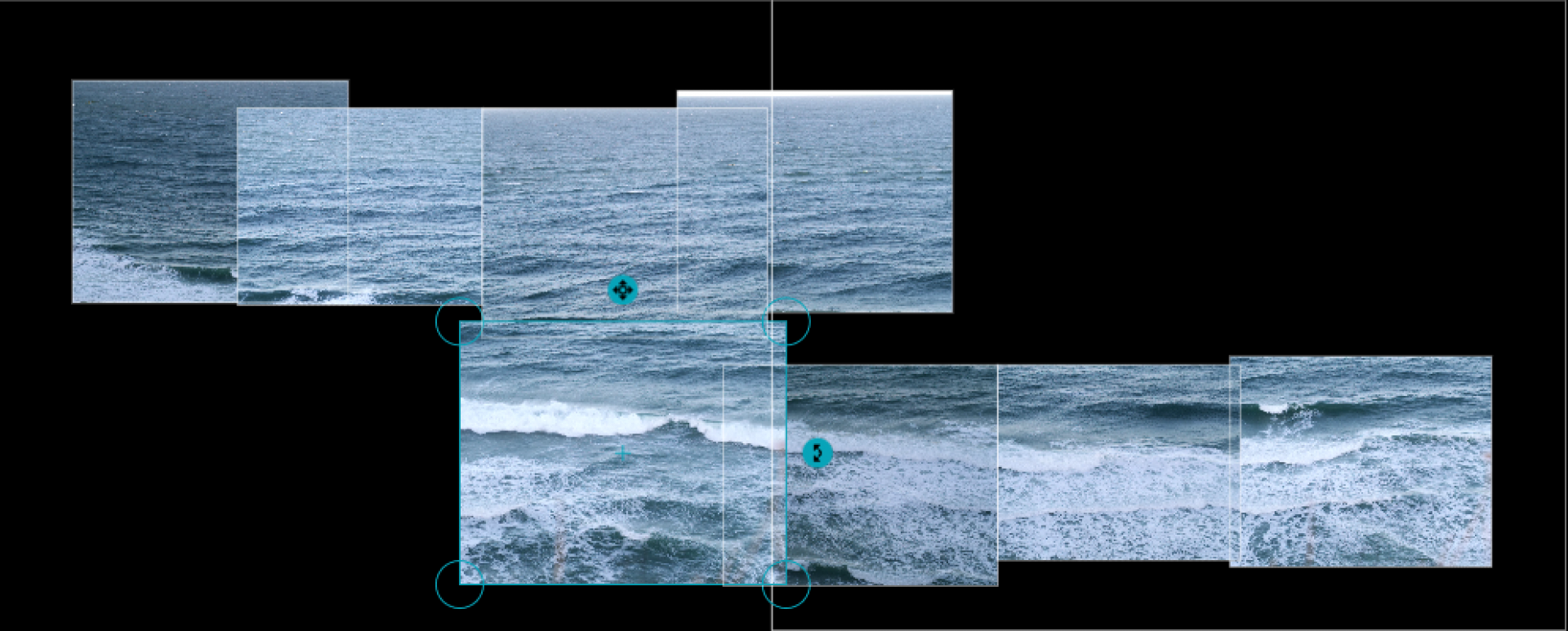
Image
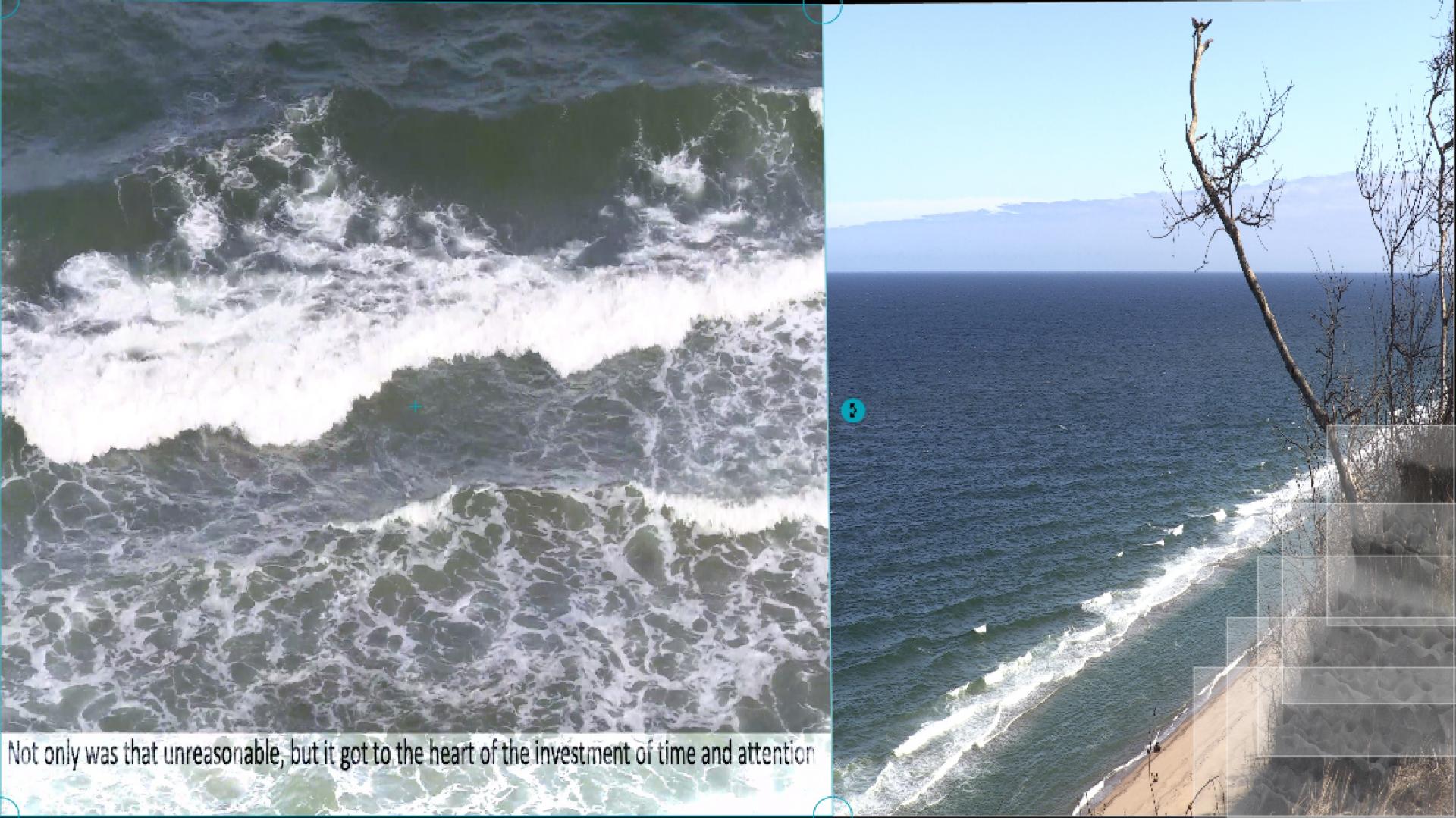
Image

Image
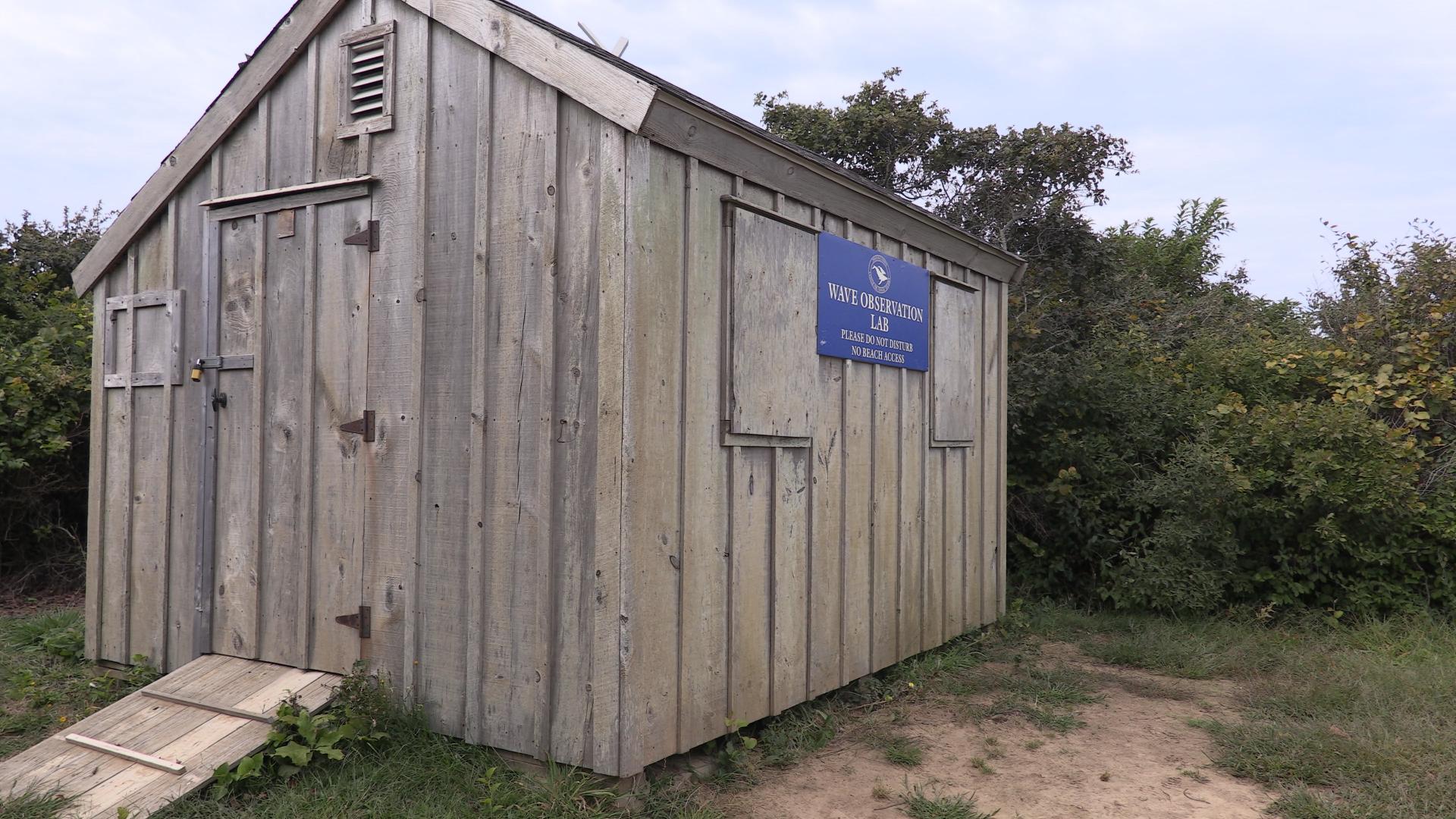
Image
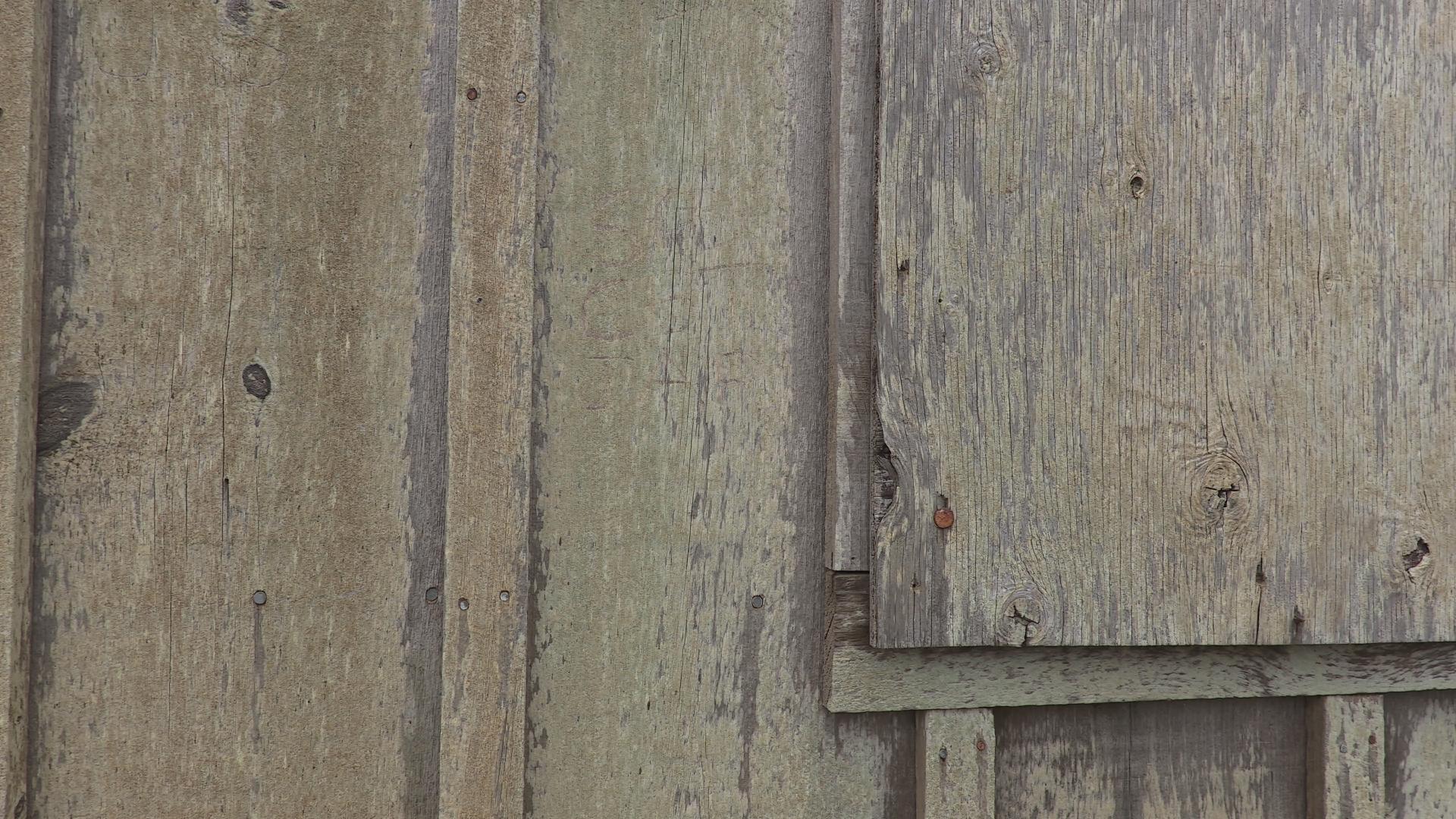
Image
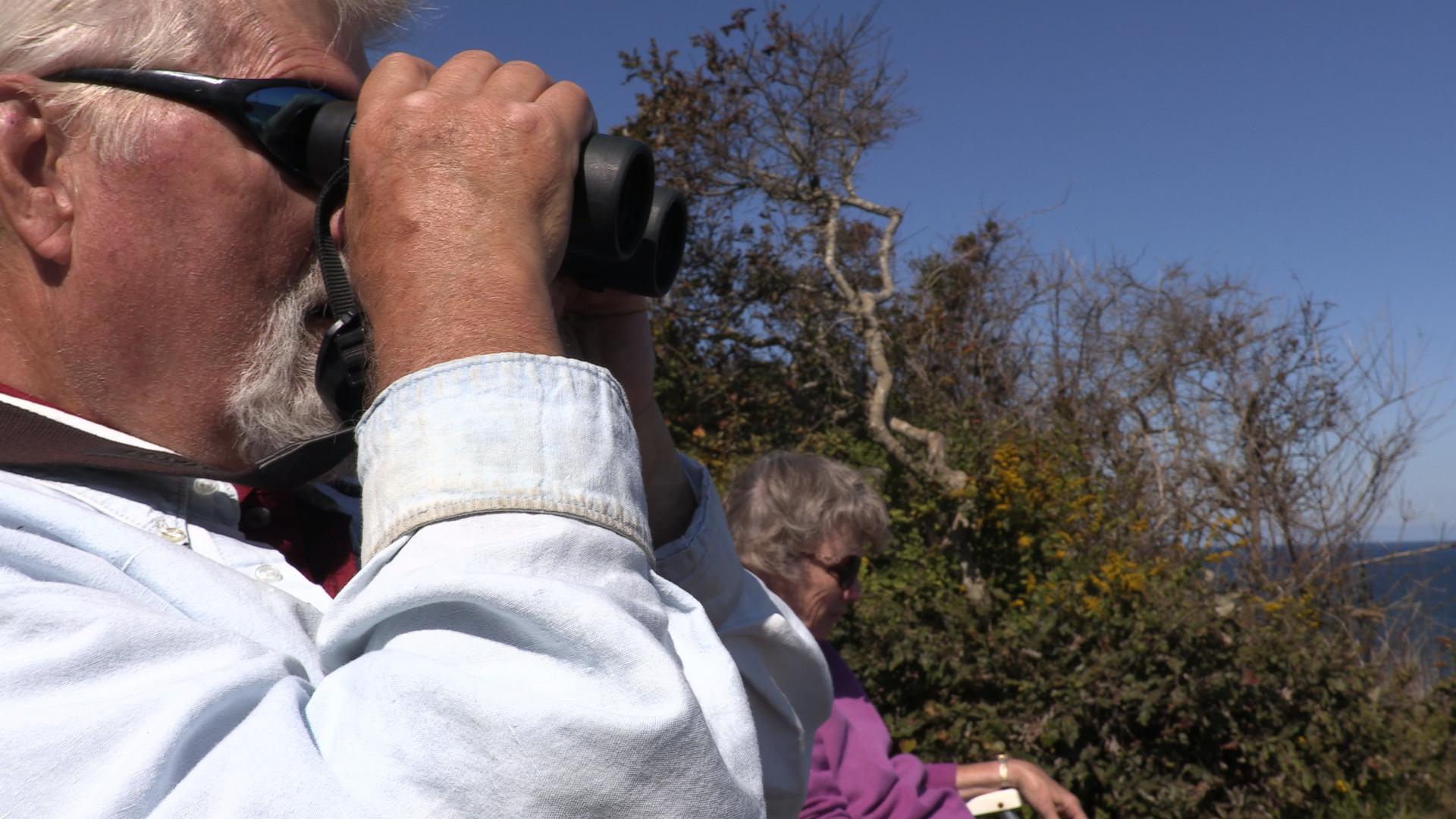
Image
Image

Image

Image
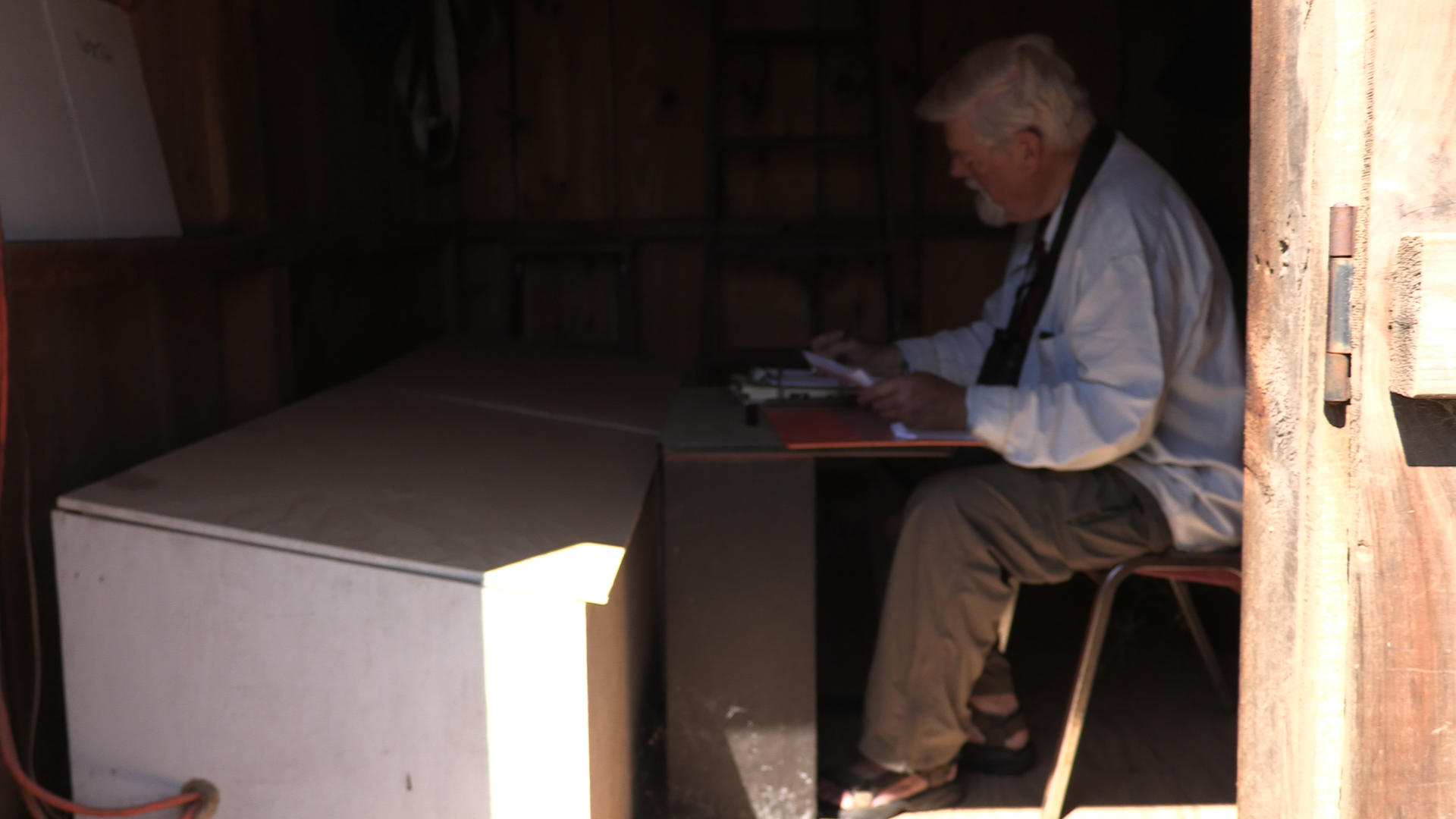
Modeling
It begins with surveying, then orienting, focusing, determining a baseline, identifying repeating elements – the pattern, concluding the observation, then reflecting on what it means.
I do this primarily through editing. I have a tryptic of monitors to allow you to survey and establish a horizon. I use video from the same place in each of the monitors to orient you. The color scheme is similar and at first the scale is similar. Through the length of establishing shots and the repetition of establishing shots, there is a sense of focus. The baseline is determined through time and the previous elements. The repeating elements emerge by comparing what has come before to what is happening now and what is happening in conjunction montage – on each side. In addition to memory and anticipation, what I am exploring can possibly be explained by the phenomena of neural adaptation, specifically the motion aftereffect. This relates to my manipulation of the frame rates of the video. The neural adaptation can also be applied to auditory experiences. The observation conclusion happens when one frame disappears, then the other two mirror each other, the second to last frame then disappears, the last center frame remains. The reflection on what it means then occurs when the video loops. The reading on the static image.
This process can be applied to other occurrences in life, whether staring at an endless starry night, or through the lens of a microscope, or into a beloved’s eyes.
For instance, early in my research, I made the citizen scientist- the wave counter- the center of the story. This repeats my personal pattern of seeking father figures and elevating them to experts. I later returned to the cliff several times, once with colleagues, then for a final time with my actual father. In this transformation from a seeker, to observer, to equal, to expert, I broke a personal development pattern.
The process can also be akin to the scientific method, which was used by the father of modern oceanography, Dr. Walter Munk to develop wave prediction. His experiments to trace ocean waves from Antarctica to Alaska in the 1960’s highlight the importance of studying the ocean. It demonstrates no one is isolated on the earth. The ocean is subject to systems that connect us all. What happens to the ocean affects everyone.
And to understand it, we need to assign meaning through data. This is where humanity’s connection to technology comes in. Scientists like the late Dr. Munk use data from specialized technology in the ocean to determine wave patterns. This is the same information the wave counter and his wife observe by eye and measure by internal time clocks. Comparing the two methods lends itself to questions of the limits of human senses or the advantages of human senses. It can lead to discussions of obsolescence and AI application. The use of handwritten records also introduces the issue of trust in science.
I was drawn to meditate on the meaning of measuring the sea by a desire to slow down the production and consumption of media. I have watched hours of the same footage of waves. It is a reaction to the quick-paced and sound-soaked edits I produced in local news for 16 years. In this piece, through omission of didactic information – what I call the greater edit- the audience has room to ask its own questions and come to its own conclusions given the right direction and context.
Image
Image
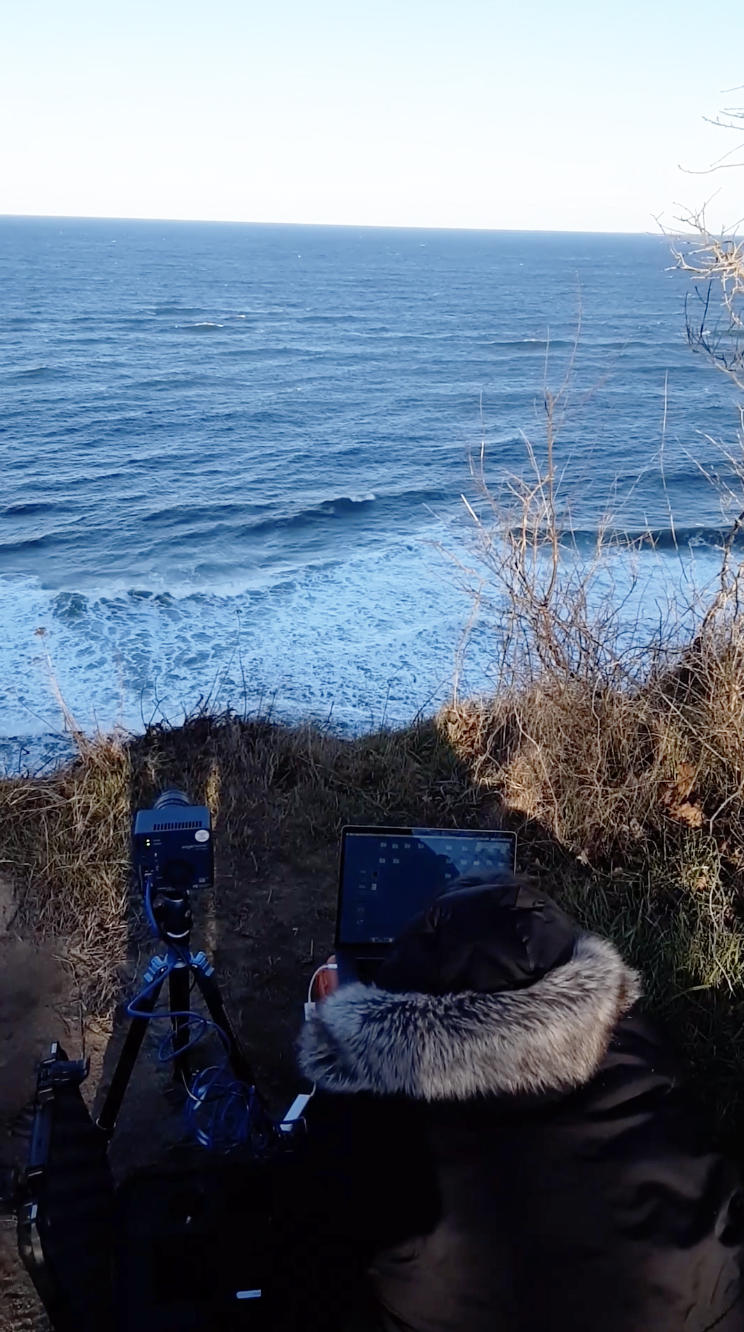
Image
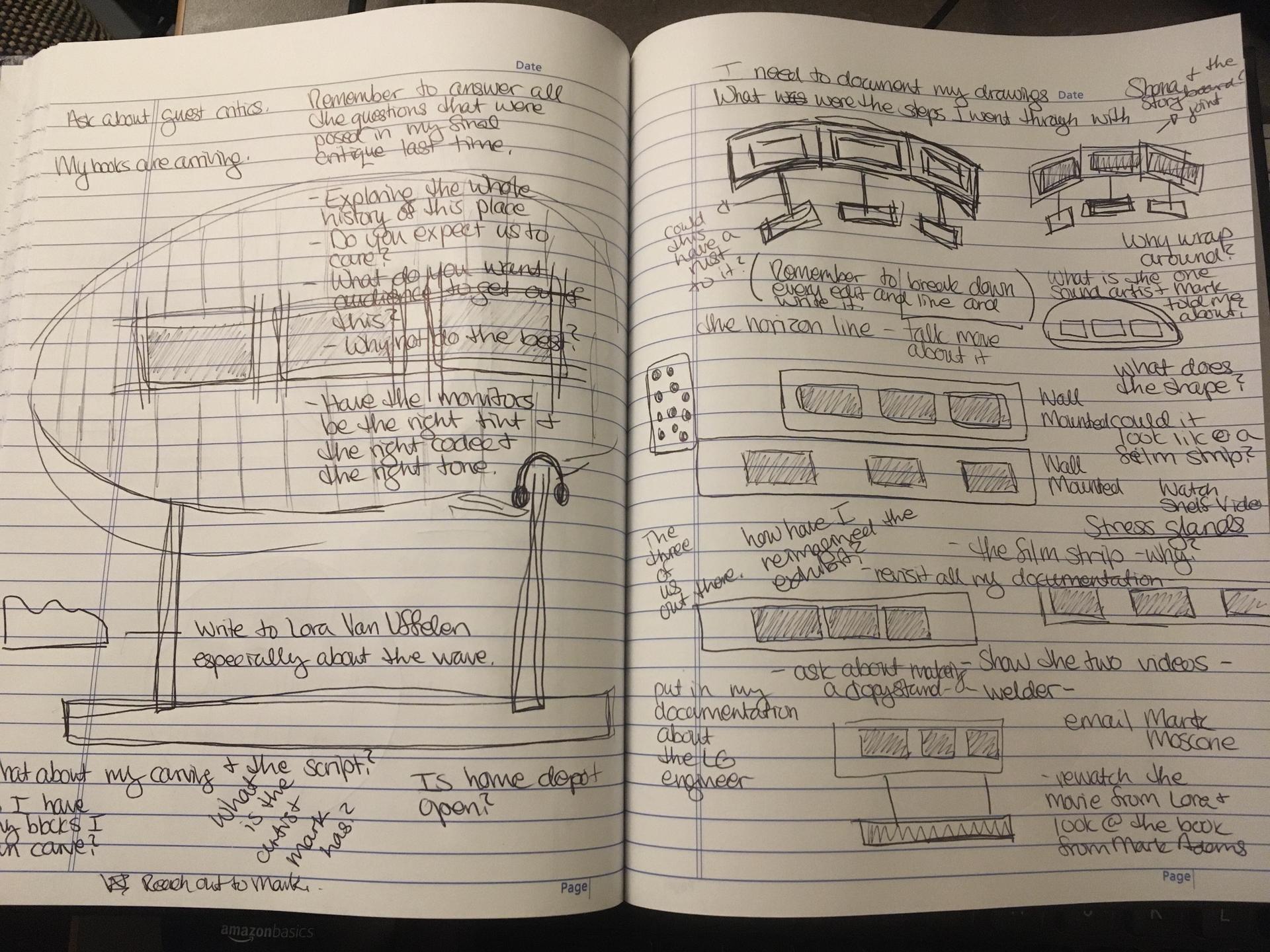
Source Material for Analysis
Image

Computer-Aided Analysis
Image
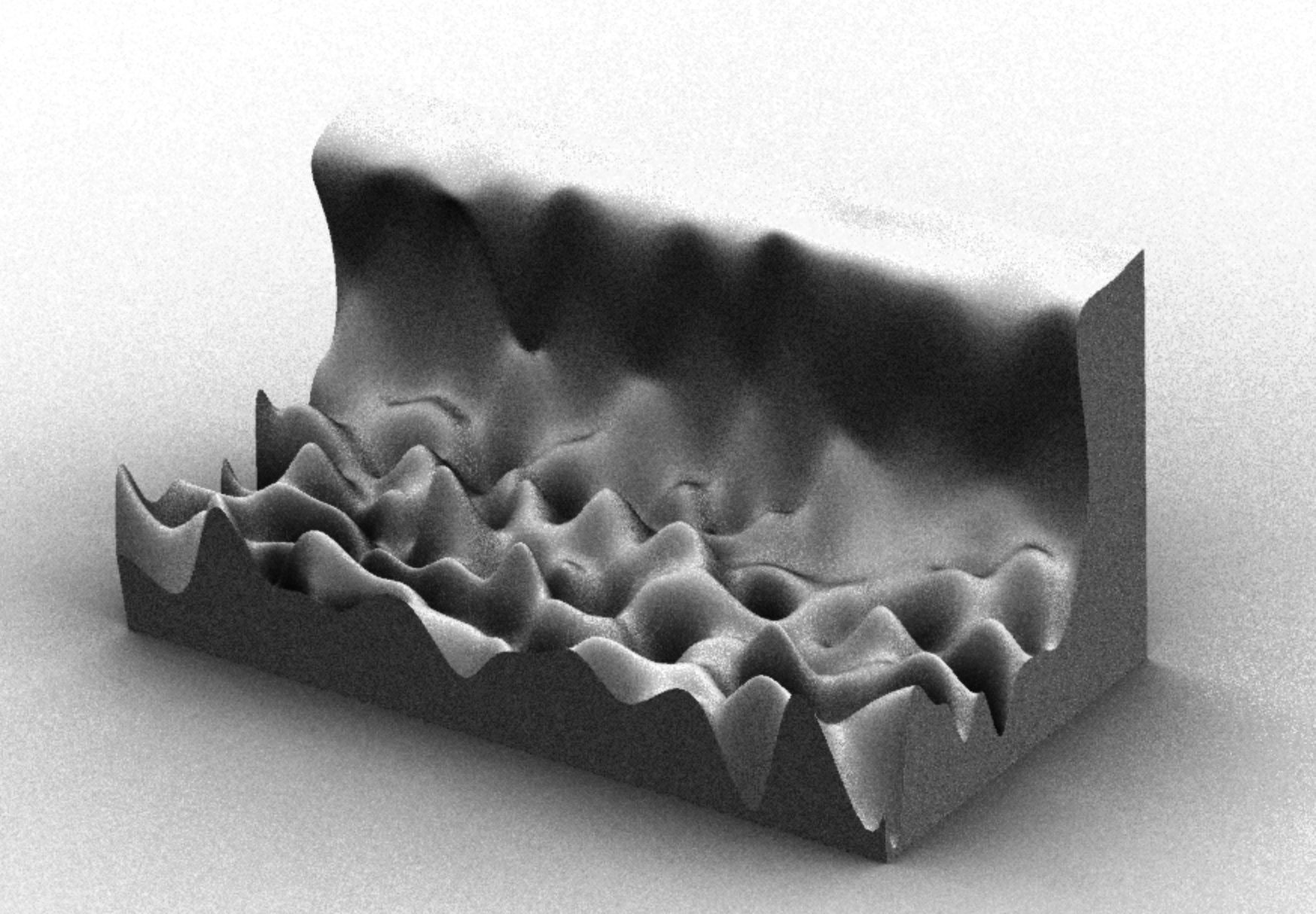
Resin 3D Print
Image
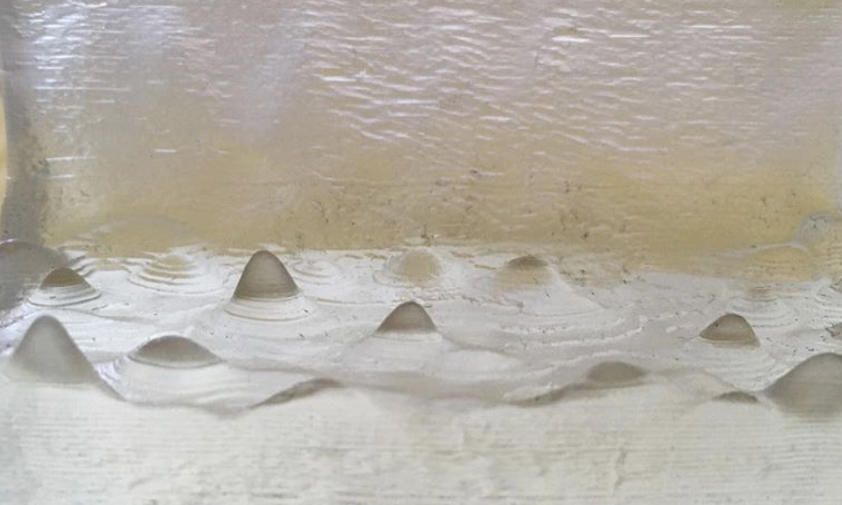
Image
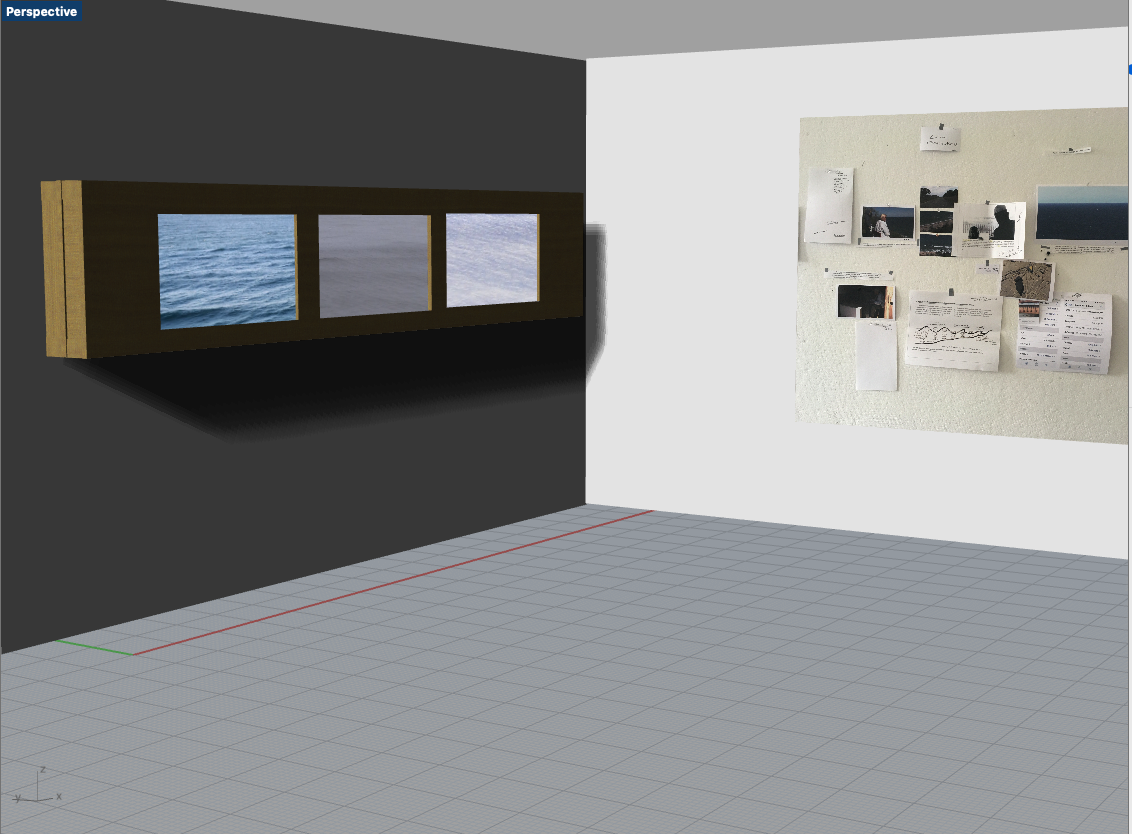
A three-channel video piece displayed as a triptych of monitors each with a view of the ocean. Each sit within a weathered wooden structure attached to a wall. All channels of the sea are recorded at the same location in New England. On an adjacent wall, documentation of my research fills in the questions posed by the abstract piece of video/sound art. Programming of three computers with the piwall language route the video to the three monitors.
Stories are vital to a society’s and an individual’s survival.
I’m an artist and researcher who folds lessons learned as a journalist into explorations of environmental issues by creating new narrative devices that rely heavily on manipulating the formal aspects of emerging technologies.
In the process, I am drawn to stories that involve humanity’s relationships to technology, whether it benefits from, is harmed by, competes with, or lives in harmony.
The work you see in front of you and hear around you is your story of discovery.
A process of making sense of media then surrendering to the interior landscape you create by ingesting and synthesizing representations of reality.
In this case, an autumnal view of the ocean from a glacial cliff on outer coast of Cape Cod, Massachusetts.
Based on my observations of the methodologies of a citizen scientist who counts and records wave patterns there, my attempts to replicate his activity, and then my reflection on the meaning of it, the editing moves you through the stages of recognizing patterns.
References for Installation
Giese, Graham S. Jeffress Williams, and Mark Adams. Coastal Landforms and Processes at the Cape Cod National Seashore, Massachusettes, A Primer. U.S. Department of the Interior, U.S. Geological Survey. 2015
One Man's Noise: Stories of An Adventuresome Oceanographer. University of California Television (UCTV) [2/1997] [Science] [Show ID: 636. https://www.youtube.com/watch?v=je3QvqNdHl0
Zirker, Jack B., The Science of Ocean Wave
https://oceanservice.noaa.gov/facts/wavesinocean.html
Waves Across the Pacific https://www.youtube.com/watch?v=MX5cKoOm6Pk
BBC Arts Hour, olafur eliasson: Earth perspectives. Released On: 09 May 2020. https://www.bbc.co.uk/programmes/p016tmg0/clips
Calvino, Italo. Mr. Palomar. Reading a Wave. https://www.uky.edu/~eushe2/Pajares/calvino/calwave.html
New Yorker Radio Hour. Rachel Carson Dreams of the Sea. April 21, 2020. https://podcasts.google.com/?feed=aHR0cDovL2ZlZWRzLndueWMub3JnL25ld3lvcmtlcnJhZGlvaG91cg&episode=OGVmOTc4YTItMTc3OC00ZDVlLTkwZjktYWQ0Y2YzMDkyZDRh&hl=en&ved=2ahUKEwjd_5Tgy_7oAhX-mHIEHd6TCS4QieUEegQICxAE&ep=6
Anstis, Stuart, Frans A.J. Verstraten and George Mather. The motion aftereffect. Trends in Cognitive Sciences – Vol . 2 , No . 3 , March 1 9 9 8
Remes, Justin, Motion(less) pictures: the cinema of stasis.
http://piwall.co.uk/information/10-create-your-own-gpl-movie-piwall
https://www.raspberrypi.org/documentation/configuration/tcpip/
https://github.com/raspberrypilearning/networking-lessons
https://www.raspberrypi.org/forums/viewtopic.php?f=38&t=247415
https://www.raspberrypi.org/forums/viewtopic.php?f=38&t=247415
https://www.raspberrypi.org/forums/viewtopic.php?t=244826
https://wiki.edgertronic.com/index.php/Main_Page
https://www.cirmmt.org/activities/distinguished-lectures/bill-seaman-lecture
https://architectureau.com/articles/dust/
https://www.artsy.net/article/artsy-editorial-video-art-form-moment
https://www.instructables.com/id/DIY-Hanging-Storage-Shelves-With-Sliding-Doors-Ove/
https://dlz.reaper.fm/userguide/ReaperUserGuide610d.pdf
Recording Immersive Audio: Binaural vs 360 vs Ambisonics
Error creating project file! Project not saved! - Cockos Incorporated Forums
Autosaving in REAPER - The FIRST thing to do when installing
Ambisonic Formats Explained - What Is The Difference Between A Format And B Format | Production Expert https://www.researchgate.net/publication/229101057_3D_Sound_field_recording_with_higher_order_Ambisonics_--_objective_measurements_and_validation_of_a_4th_order_spherical_microphone
(PDF) Introduction to Ambisonics
Introduction — Facebook Audio 360 documentation
Recording Immersive Audio: Binaural vs 360 vs Ambisonics
My Debt of Gratitude Goes To:
Shona Kitchen
Aly Ogasian
Stephen Cooke
Nora Khan
Dr. Lora Van Uffelen
Edek Sher
Tucker Houlihan
Mark Cetilia
Shawn Greenlee
Emily Bright
Mark Moscone
Peter Stempel
and the cohorts of RISD Digital + Media 2019, 2020, & 2021